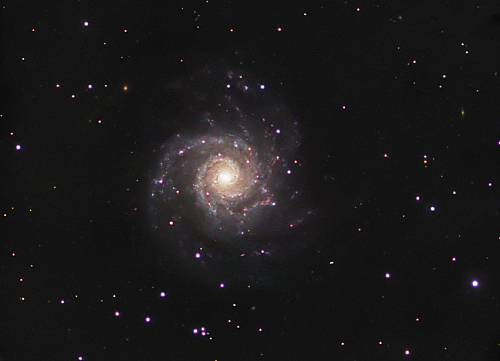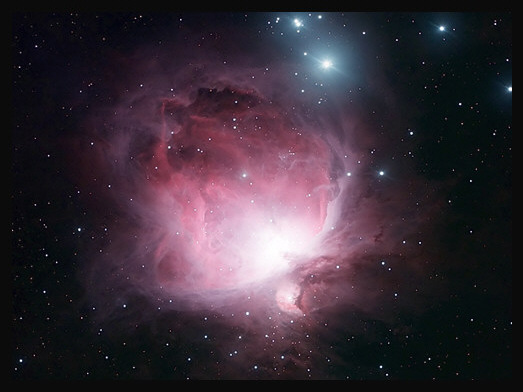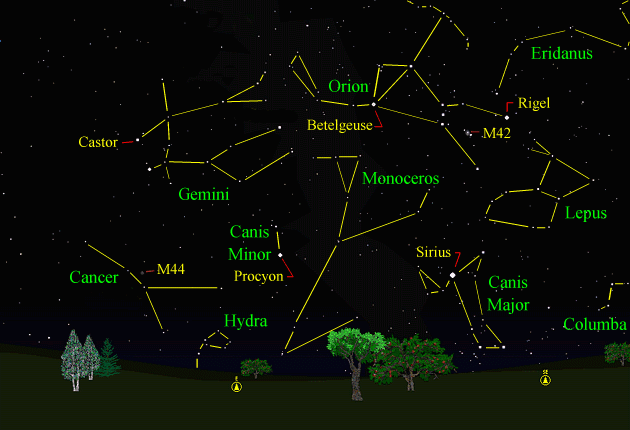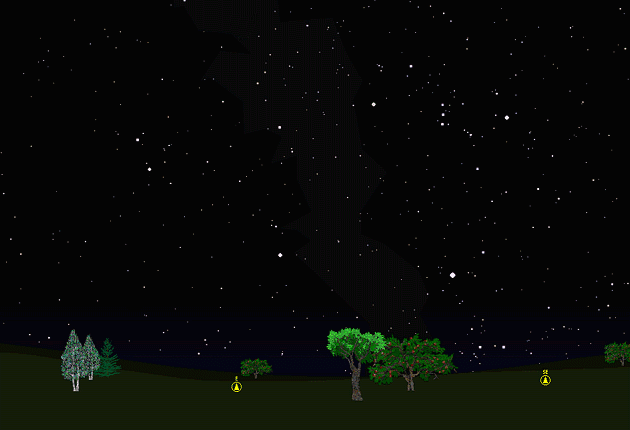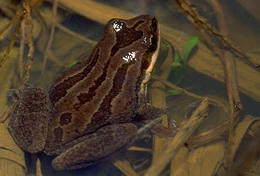The purpose of this feature is to give scout leaders, educators and naturalists an idea of some of the natural events coming up each month. We will try to cover a variety of natural events ranging from sky events to calling periods of amphibians, bird and mammal watching tips, prominent wildflowers and anything else that comes to mind. We will also note prominent constellations appearing over the eastern horizon at mid-evening each month for our area for those who would like to learn the constellations. If you have suggestions for other types of natural information you would like to see added to this calendar, let us know! Note: You can click on the hyperlinks to learn more about some of the featured items. To return to the Calendar, hit the "back" button on your browser, NOT the "back" button on the web page. All charts are available in a "printer friendly" mode, with black stars on a white background. Left clicking on each chart will take you to a printable black and white image.
Notes and Images From November 2008 Spiral galaxy Messier 74 has the reputation of being the hardest object to see in the Messier catalog. It was discovered in September of 1780 by Pierre Mechain, who wrote, "This nebula ... is quite broad, very dim, and extremely difficult to observe; it may be distinguished more accurately during fine frosts." I spent some time imaging the galaxy, and while the 6-inch refractor ticked off the exposures, I used my old twenty-two power, 60mm Bushnell spotting scope to see if I could spot the galaxy visually. I found I could see it only with averted vision, looking to one side of its known position. It then appeared in my peripheral vision as a very faint misty patch of light. When I looked directly at it, it would disappear. But glimpsing it at all, knowing that the photons that I was seeing were ending a 35 million year journey, was very satisfying. The 6-inch refractor was completely covered with frost1, and I thought about Mechain's words. Fall nights still bring us frosty weather, and night skies that hint of far away realms. Because of its relatively large size and low surface brightness, M74 may be difficult to see from light-polluted skies even with large telescopes. In dark skies it may be visible in a small telescope at low magnification. For all telescopes, the main requirement is a sky relatively free from light pollution. For more about light pollution, and what you can do about it, you may want to check out the International Dark Sky Association web site. For more about the galaxy, tips on observing it, finder charts, and an asteroid "movie," click on the image above. Sky Images 2008 - This slide show features some of our favorite images of the night sky taken over the last twelve months. All were made from our farm near Franklin, Tennessee. It will take a moment to download.
Sky Events for December 2008: The winter solstice, marking the beginning of winter in the northern hemisphere, occurs at 6:04am CST on December 21st. This is the shortest day of the year. The earliest sunset of the year occurs on December 5th for our latitude. The earliest sunset and latest sunrise dates do not coincide with the solstice because of two factors; the tilt of the Earth's poles relative to the plane of its orbit and the elliptical shape of the Earth's orbit. The latest sunrise occurs in January. Evening Sky: Jupiter, Venus and the crescent Moon form a beautiful, tight grouping in the western sky after sunset on December 1st. During the month Venus will continue to climb higher into the southwestern sky after sunset, while Jupiter will sink lower. By the end of the month the two planets will be separated by 30 degrees. In the last few days of the month, watch for Mercury to make an appearance above the southwestern horizon. On December 28th, look for Mercury a little over 3 degrees below Jupiter, and on December 31st, look about 1 degree to the left of Jupiter. A good time to observe the pair is about 40 minutes after sunset. Saturn rises around 11:20pm CST at midmonth in Leo.
Morning Sky: The
Geminid meteor shower
peaks on the morning of December 14th. The
Moon, just past full, will brighten the sky and wash out all but the
brightest meteors. All times noted in the Sky Events are for Franklin, Tennessee and are Central Daylight Time. These times should be pretty close anywhere in the mid-state area. Constellations: The charts below show the sky looking east at 9:30pm CST on December 7th. The first view shows the sky with the constellations outlined and names depicted. Star and planet names are in yellow. Constellation names are in green. The second view shows the same scene without labels.
Compare the bright stars Betelgeuse and Rigel in Orion. Betelgeuse is a red giant and the star Rigel is a very hot, very bright supergiant. Compare the color of the two stars. If you have a telescope, point it to the center of the three "sword" stars below Orion's belt. There you will find the Orion Nebula, M42, one of the most magnificent emission nebulas in the sky. The pink glow of hydrogen alpha light is visible only in very large telescopes and the nebula appears as a small greenish glow in small telescopes. Crouching beneath the feet of Orion, is Lepus, the Hare. Below Lepus is Columba, the Dove. Sirius, the brightest star in the sky, shines below Orion. Sirius is in Canis Major, the Great Dog, and for that reason is known as the Dog Star. In the late summer, Sirius rises at the same time as the sun. Because of this, these late summer days are known as “the dog days." The faint constellation Monoceros, the Unicorn, follows Orion over the eastern horizon. Low in the eastern sky below Gemini is Canis Minor, with its bright star Procyon. Procyon means, "before the dog," and refers to the fact that Procyon rises just before the Dog Star, Sirus. Look below Gemini and see if you can spot the faint glow of M44, the "Beehive Cluster." This cluster is located in Cancer, the Crab. Finally, Hydra, the Water Serpent, rears its head just above the eastern horizon.
On Learning the Constellations: We advise learning a few constellations each month, and then following them through the seasons. Once you associate a particular constellation coming over the eastern horizon at a certain time of year, you may start thinking about it like an old friend, looking forward to its arrival each season. The stars in the evening scene above, for instance, will always be in the same place relative to the horizon at the same time and date each December. Of course, the planets do move slowly through the constellations, but with practice you will learn to identify them from their appearance. In particular, learn the brightest stars (like Sirius and Procyon in the above scene), for they will guide you to the fainter stars. Once you can locate the more prominent constellations, you can "branch out" to other constellations around them. It may take you a little while to get a sense of scale, to translate what you see on the computer screen or what you see on the page of a book to what you see in the sky. Look for patterns, like the three stars in a line in Orion's belt. The earth's rotation causes the constellations to appear to move across the sky just as the sun and the moon appear to do. If you go outside earlier than the time shown on the charts, the constellations will be lower to the eastern horizon. If you observe later, they will have climbed higher. As each season progresses, the earth's motion around the sun causes the constellations to appear a little farther towards the west each night for any given time of night. If you want to see where the constellations in the above figures will be on January 7th at 9:30pm CST, you can stay up till 11:30pm CST on the December 7th and get a preview. The westward motion of the constellations is equivalent to two hours per month. For instance, if you want to see what stars will be on your eastern horizon on March 7th at 9:30pm CST (3 months later), you would need to get up at 3:30am CST in the morning on December 7th (3 months times 2 hours/month = 6 hours). Recommended: Sky Publishing has just come out with a beautiful and compact star atlas, Sky & Telescope's Pocket Star Atlas. It is destined to become a classic, and is a joy to use at the telescope. A good book to learn the constellations is Patterns in the Sky, by Hewitt-White. You may also want to check out at H. A. Rey's classic, The Stars, A New Way to See Them. For skywatching tips, an inexpensive good guide is Secrets of Stargazing, by Becky Ramotowski. A good general reference book on astronomy is the Peterson
Field Guide,
A Field Guide to the Stars and Planets, by Pasachoff. The book retails for around $14.00. Starry Night has several software programs for learning the night sky. Visit the Starry Night web site at www.starrynight.com for details.
Amphibians:
December really marks the beginning of the breeding season for our Tennessee frogs and toads. We have had breeding choruses of Upland Chorus Frogs as early as December 4th. Breeding even before Wood Frogs, these irrepressible inhabitants of flooded winter fields and other wet areas will call throughout the cold winter months. Listen for their call, which sounds like someone dragging their thumb across the teeth of a plastic comb, on mild wet winter evenings. Listen also for Southern Leopard Frogs. We hear them throughout the fall. Many other Tennessee frogs and toads can also be seen on mild December nights, but most are silent.
Birds: If you walk grassy fields that have some wetter areas, you may flush a Short-Eared Owl, a winter resident in Tennessee. We have flushed them from fields at Pardue’s Pond near Ashland City, along the roads that go to Pace Point near Big Sandy, Tennessee, at Britton Ford near Dover, Tennessee and at Savannah Bottoms, south of Savannah, Tennessee. These birds tend to occupy the same habitat as Northern Harriers, so if you see Harriers over grassy fields, be on the lookout for the owls. They often begin flying in the late afternoon, coursing over the fields like a Harrier. It’s a good idea to check any “Northern Harrier” you see in the late afternoon to make sure it’s not a Short-eared Owl. Through the end of December, listen for the courtship dueting of Great Horned Owls at dusk and dawn. You probably have already put out your bird feeders, but if you haven’t you're missing out on a lot of good looks at winter feeder birds. This is a great time of year to start learning your birds. Watch and listen for winter residents such as White-throated and White-crowned Sparrows, Yellow-bellied Sapsuckers, Pine Siskins, Red-breasted Nuthatches, Golden-crowned Kinglets and Brown Creepers. Recommended: Bird Finding in Tennessee, Michael Lee Bierly. A classic guide to finding birds in Tennessee. The Sibley Guide to Birds, David Allen Sibley The Sibley Guide to Birds of Eastern North America, David Allen Sibley
An inexpensive guide for beginners is the Golden Guide for Birds.
Archives (Remember to use the back button on your browser, NOT the back button on the web page!) Natural Calendar November 2008 Natural Calendar September 2008 Natural Calendar February 2008 Natural Calendar December 2007 Natural Calendar November 2007 Natural Calendar September 2007 Natural Calendar February 2007 Natural Calendar December 2006 Natural Calendar November 2006 Natural Calendar September 2006 Natural Calendar February 2006
Natural Calendar
December 2005
Natural Calendar
November 2005
Natural Calendar
September 2005
Natural Calendar
February 2005
Natural Calendar
December 2004
Natural Calendar
November 2004
Natural Calendar
September 2004
Natural Calendar
February 2004
Natural Calendar
December 2003
Natural Calendar
November 2003
Natural Calendar
September 2003 Natural Calendar February 2003 Natural Calendar December 2002 Natural Calendar November 2002 Nature Notes Archives: Nature Notes was a page we published in 2001 and 2002 containing our observations about everything from the northern lights display of November 2001 to frog and salamander egg masses. 1 With refractors and other telescope designs that have an optical element at the sky end of the telescope tube, amateur astronomers soon discover the need for an anti-dew/anti-frost system in place to keep optical surfaces clear. These systems are available from many astronomical equipment suppliers like Orion (http://www.telescope.com/. Night scenes prepared with Starry Night Pro software All images and recordings © 2008 Leaps |
